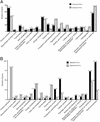Determination of the transcriptome of Vibrio cholerae during intraintestinal growth and midexponential phase in vitro
- PMID: 12552086
- PMCID: PMC298765
- DOI: 10.1073/pnas.0337479100
Determination of the transcriptome of Vibrio cholerae during intraintestinal growth and midexponential phase in vitro
Abstract
Vibrio cholerae is the etiologic bacterial agent of cholera, a severe diarrheal disease endemic in much of the developing world. The V. cholerae genome contains 3,890 genes distributed between a large and a small chromosome. Although the large chromosome encodes the majority of recognizable gene products and virulence determinants, the small chromosome carries a disproportionate number of hypothetical genes. Thus, little is known about the role of the small chromosome in the biology of this organism or other Vibrio species. We have used the rabbit ileal loop model of V. cholerae infection to obtain in vivo-grown cells under near midexponential conditions in the small-intestinal environment. We compared the global transcriptional pattern of these in vivo-grown cells to those grown to midexponential phase in rich medium under aerobic conditions. Under both conditions, the genes showing the highest levels of expression reside primarily on the large chromosome. However, a shift occurs in vivo that results in many more small chromosomal genes being expressed during growth in the intestine. Our analysis further suggests that nutrient limitation (particularly iron) and anaerobiosis are major stresses experienced by V. cholerae during growth in the rabbit upper intestine. Finally, relative to in vitro growth, the intestinal environment significantly enhanced expression of several virulence genes, including those involved in phenotypes such as motility, chemotaxis, intestinal colonization, and toxin production.
Figures



References
Publication types
MeSH terms
Substances
Grants and funding
LinkOut - more resources
Full Text Sources
Other Literature Sources
Molecular Biology Databases

